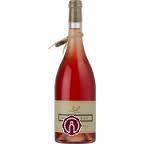Review of Goose Bay Blanc de Pinot Noir 2013, the Domaine Lafond Roc Epine Tavel Rosé 2011 and Dupuy XO Cognac.
By Joshua E. London and Lou Marmon
Washington Jewish Week Spring 2015

Rosés are usually made by minimizing the grape skin contact with the juice, since all the pigmentation comes from the skin. Saignee, the French word for “bleeding,” is another technique whereby some of the lighter juice is poured off to make a rosé, allowing the remaining juice to become more concentrated. Though permitted elsewhere, blending white and red wine to create a rosé is proscribed in France.
Rosé wine sales have been steadily increasing as consumers become more aware of their food pairing versatility, as compared to most reds or whites. Likewise in the religious Jewish world, where there is a preference for red wines over white, owing to traditional rabbinic references to red wine being better and therefore preferable for Kiddush, folks have begun to realize that “pink” wines are close enough and far more palatable than “Kiddush” style sweet wines. This, in turn, means there are more kosher wine producers making Rosé wine.
Alas, whenever a particular type of wine becomes popular, there are those who decide that there also needs to be a “luxury brand” version available as well. In Provence, a region of France known for their Rosés, Château d’Esclans is producing the world’s most expensive Rosé. Named “Garrus” and created by co-fermenting Grenache and a white varietal Rolle from 80 year old vines, it boasts stylish packaging and a price tag of $80 to $100 a bottle. Meant to age rather than be quaffed in the here and now, we can’t help but question the point of such a wine. Nearly 15 % of the 600 or so wineries in Provence now release a “luxury” bottling so there must be a market for this stuff. With any luck, the kosher wine world will resist the temptation to follow this lamentable path.
Most rosés are light and easy drinking, best served while young and very chilled. While France produces some exceptional kosher Rosé wines, there are also some really excellent examples to be found elsewhere. Consider, for example, the Goose Bay Blanc de Pinot Noir 2013 ($22), a lovely fun refreshing and slightly off dry Rosé that is uncomplicated but not simplistic. It is nicely balanced with soft but present acidity, sweet ripe strawberry, raspberry and subtle watermelon notes and some lovely, vibrant aromatics of berries, peach, plum and flowers.
Even though most rosé wines, even from France, are made in this light, fun, easy drinking style, those in the in the mood for a more complex, richer and slightly more brooding French rosé, should look to Tavel, in France’s southern Rhone valley. Tavel is the only appellation that produces exclusively rosé wines, while there are a few kosher Tavel on the wider market, one of our favorites, and one of the only ones widely available in the US, is Domaine Lafond Roc Epine Tavel Rosé 2011 ($26), this lovely organic wine is vibrant and concentrated, offering currant and raspberry aromas with deep red fruit flavors and noticeable minerality on a medium frame with terrific balance, complexity and length. Not a rosé for the meek nor to sip solo, rather this beauty demands some food accompaniment, and can be paired nicely with grilled foods.
Spirits-wise we thought we’d stick with something wine based yet hefty enough to deliver the goods: Dupuy XO Cognac (40 percent abv; $85; comes in a nonkosher version too, so make sure to check for the kosher certification): This smooth and aromatic cognac spent more than a dozen years maturing in Limousin French oak casks and showcases generous notes of vanilla and cinnamon, with a good and balanced mid-palate offering of dried fruits and additional notes of walnuts, dates and almonds, all leading up to an enjoyable and involved if slightly clipped finish. L’Chaim!
